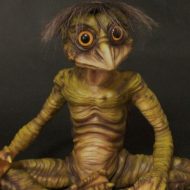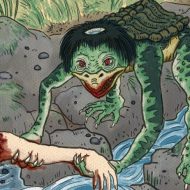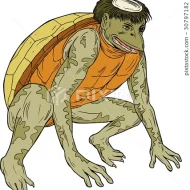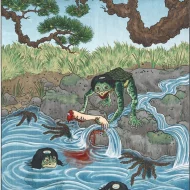Kappa : The River Menace
Listen
At a glance
| Description | |
|---|---|
| Origin | Japanese Mythology |
| Classification | Hybrids |
| Family Members | N/A |
| Region | Japan |
| Associated With | Rivers, Man Eating |
Kappa
Introduction
In Japanese folklore, the term Kappa refers to a type of vampire-like creature that is less malevolent toward men than the devilish oni. It is also believed that this creature taught humans how to boneset. These aquatic reptilian creatures live in streams and rivers all across Japan.
These creatures are aquatic creatures, and they enjoy basking in the warm waters during the summer season. Although they’re small, they’re strong and can swim well. One of the most common creatures in Japanese folklore is the Kappa, who was once regarded as a dangerous and malicious individual.
It was not advised for children to swim near rivers. He was known to attract people by saying that he would eat their flesh if they got too close. Old signs with the phrase “Be aware” have been found in the area.
Physical Traits
The Kappa is generally considered to be a size and shape of a child. It has a beak and shell that resembles a turtle, and its body is built for swimming. Its waterproof and elastic skin is said to smell like fish. Kappas have three anuses, which allow them to travel three times faster than humans. Their forearms are connected to one another using their shells’ internal mechanisms. When one of these arms is pulled on, it lengthens the other.
Their skulls are covered in a dish-like depression, which is believed to be the source of their power. This condition prevents the creatures from moving and could even kill them if the water gets too dry. Japanese people also believe that the creatures have green hairless bodies, similar to those of a child.
Kappas have circular dishes all around their heads, and they have pointed beaks that are usually yellow. They also have webbed feet and hands, and they are known to catch swimmers’ feet and drag them to a lifeless end. Today, the Kappa is often depicted in cartoons as a playful and mischievous creature.
Family
Although adults are usually solitary, they can be found in family groups. They are also known to befriend people. They are fiercely honorable creatures, and they never break their promises. In addition to being capable of learning a human language, they are also knowledgeable about the art of setting bones and medicine. Legend has it that this skill was passed down to humans by a friendly Kappa.
Other names
The name Kappa comes from the words “kawa” and “wappa,” which are both variants of “child.” It is also translated as “water Sprites.” There are over eighty other names of Kappa that are commonly found in Japan. Some of these include “kawauso,” “otter,” “dangame,” and “monkey.” The combination of these words suggests that the creatures look similar to humans.
The term “komahiki” refers to the Kappa’s alleged desire to pull horses. In Izumo, where Lafcadio Hearn lived, the animal was referred to as kawako. In Hygo Prefecture, it was called gatar.
Powers and Abilities
Kappas are known to be violent and cruel. They are also fond of poking around women’s kimonos and passing gas in public. Their preferred method of killing someone is by drowning them or biting them to death. They are particularly cruel towards horses and cows.
Kappas are known to abduct and rape people, as well as women who are swimming. They usually target a ball of flesh inside an anus, which is referred to as the Shirikodama. On the other hand, in land, they can outwit one by returning a bow. They can also be tricked into bowing down low, which would allow them to overcome obstacles.
Kappas are known to swear allegiance to their champions throughout their lives. If you come into contact with one of these creatures, you will not be able to escape. There are two ways to try and escape: First, they are obsessed with cucumbers, which they consider to be better than human flesh.
You can thank the Kappa by giving him a cucumber, as it will give you an opportunity to live. During the Edo period, people would throw in river cucumbers with their names and birth dates on it, hoping that it would keep them from getting killed. This was believed to be a way for the family to ensure that they would not get killed by the yokai.
If you are not able to have a cucumber on hand, you can still use the second method, which is to greet like a Japanese creature. This is because being of rare politeness, they will gladly greet you if you come across them. The key to this is to run as fast as you can because their head will be empty because of their salute.
Modern Day Influence
The Kappa is a popular creature in Japanese folklore. Its various manifestations can be found in folk religion, legends, folklore, and folk metaphors. In Japanese literature, the character of Sha Wujing, who is a Kappa, is seen as a kind of comrade of a magic monkey named Sun Wukong in Journey to the West.
King Kappa, a kaiju featured in the 1972 anime series Ultraman Ace, is a representation of Japan as a nation. In their commercial conceptions, these yokai no longer represent a frightening or mysterious entity. Instead, they are anthropomorphic creatures that are cute and almost likeable.
Related Images
Frequently Asked Questions
What is lorem Ipsum?
I am text block. Click edit button to change this text. Lorem ipsum dolor sit amet, consectetur adipiscing elit. Ut elit tellus, luctus nec ullamcorper mattis, pulvinar dapibus leo.
What is lorem Ipsum?
I am text block. Click edit button to change this text. Lorem ipsum dolor sit amet, consectetur adipiscing elit. Ut elit tellus, luctus nec ullamcorper mattis, pulvinar dapibus leo.
What is lorem Ipsum?
I am text block. Click edit button to change this text. Lorem ipsum dolor sit amet, consectetur adipiscing elit. Ut elit tellus, luctus nec ullamcorper mattis, pulvinar dapibus leo.
What is lorem Ipsum?
I am text block. Click edit button to change this text. Lorem ipsum dolor sit amet, consectetur adipiscing elit. Ut elit tellus, luctus nec ullamcorper mattis, pulvinar dapibus leo.
What is lorem Ipsum?
I am text block. Click edit button to change this text. Lorem ipsum dolor sit amet, consectetur adipiscing elit. Ut elit tellus, luctus nec ullamcorper mattis, pulvinar dapibus leo.








